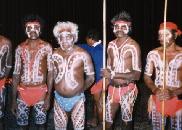In the early 1990s, evidence was found that Aboriginal people first set foot in Kakadu National Park over 50, 000 years ago.
These people led a nomadic, or semi-nomadic life, and before the non-aboriginal people arrived, there were over 20 clan groups in the Kakadu National Park area, now, only 19 clans continue live and own about 50% of the land.
The Gagadju speaking Aboriginals were believed to be the National parks original inhabitants.
Who
After the population of Aboriginals in Kakadu hit an all time low in the late 1970s, the numbers have practically tripled to approximately 550 now. Kakadu is home to Bininj (Mungguy), Mirrar (Gundjeihmi) and Murlugan peoples who make up about 19 clans in the actual national park.

Relationship with Kakadu
Approximately half of the land in Kakadu is Aboriginal land under the Aboriginal Land Rights (Northern Territory) Act 1976 and most of the remaining land is currently under claim by Aboriginal people.
The traditional Aboriginal owners of the Park are descendants of various clan groups from the Kakadu area. Although their lifestyle has changed due to white people's involvement, their traditional beliefs and traditional customs are still very important to them.
For the Aboriginals of Kakadu, the 5000 or more recorded rock art sites are an integral link with the land and it’s cultural and spriitual legacies.
The land and the Aboriginal people who live there are in a partnership. The is no ‘master and sevant’ relationship. To the Aboriginals of Kakadu, to lose the land is to lose part of yourself. You must adapt to the land, not force the land to adapt to your wants and needs.

Cultural Beliefs
The Aboriginal people of
The ancestors made the laws that the people live by, including language, kinship, and the knowledge of the land. They taught the Aboriginal people how to live with the land, and how to look after it.
In the Kakadu region, the Great Earth Mother is of great importance and a major part of Aboriginal beliefs of Ancestral beings. She is a symbol of fertility and a creator of life. But her importance to the Gagudju people goes beyond fertility to the responsibility of coming of the rains.
The Gagudju people called her Imberombera. They believe she came across the sea to the coast of
Ungulla is another fertility mother, who came to the land some time after Imberombera. As she passed through the land she met the children left by Imberombera. She beared many children for the women of the country, and before leaving, she is said to have torn out her vagina and uterus, throwing them to the women saying “From now on this will be yours. You can have the children from now on.” She also gave the women her breasts and fighting stick, and a flat spear thrower and reed spear to the men.
Aboriginal art has revealed that the Aboriginals that inhabited the Kakadu region believed that the land owned the people, not the other way around.

Social Issues
If you compare the differences between the Indigenous and non-Indigenous peoples in
Although this is a generalisation, it has ben known to occur in the Kakadu region as well.
By Ashleigh